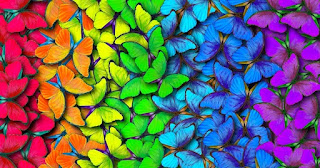Ah, the good ol' Color Wheel. You remember this guy, right? Didn't we all make one of these in grade school with too much glitter and tempera paint? Just me? Okay.
Today we're focusing on that outer ring, the Hue. Like the picture says, Hue is the pure color without any gray, black or white added. This color wheel has some other stuff going on, as you can see, but let's just focus on the Hues, shall we?
At the most basic level, you find your primary, secondary, and tertiary colors in the Hue ring. What are those (skip ahead if you know this already - as I said last time, this is a primer from the ground up so I may explain things you already know)
I preface this by saying...yes...There are more than one model describing Primary, Secondary, and Tertiary colors and these are used for different purposes. I'm going with the Red-Yellow-Blue (RYB) as it's the most basic and what most folks are familiar with. But know that others exist...like Red-Green-Blue (RGB, used often in image editing online),and Cyan-Magenta-Yellow (CMY, used often in print settings). Let's keep it simple and go with RYB. Okay? Okay.
Primary - The primary colors are the three that make up all other colors to some degree - red, yellow and blue - and are the least complex. These colors are not the result of mixing any other colors. There's nothing you can mix together to get a true, primary red. Red just is. Ditto for blue and yellow.
Secondary - The secondary colors are the result of mixing any two of the three primary colors; red + yellow yields orange, yellow+ blue yields green and blue + red yields violet. They're still fairly pure, but have more complexity than the primaries. Add those two colors in different proportions and you will get variations.
Tertiary - These colors are yet more complex. I like to think of these in Crayola color terms; Violet-Red, Red-Violet, Yellow-Green, Blue-Purple...all of the least creatively named, yet prettiest (in my opinion) crayons of the Crayola 24 pack. These colors are achieved by mixing one primary color and one secondary color, so they end up being the "in-between" colors, not quite one or the other. This is one way to get your darks and brights of secondary colors without adding white or black.
Understanding hues is super helpful when you're picking your palette for your quilt. Think of the hue like the foundation of your house. Your house needs a foundation to be built on, just like your quilt needs color to grow from. By knowing how a hue is built and where it sits on the Color Wheel, you can more easily choose the colors to go with it. Each hue has a built in set of colors it naturally looks nice with, both yielding different visual effects: the accompanying colors can either be Analogous or Complementary.
So, what does that mean? For the sake of example, let's say I've chosen a purple focus fabric:
Analogous - Analogous colors are the colors that are immediately next to each other on the Color Wheel, and are made up of one primary, one secondary and one tertiary. Since my focus fabric is purple, my analogous color set could either be red, red-violet and violet or blue, purple (aka blue-violet) and violet. Analogous colors in quilts create a softer, calmer more blended appearance (even if your focus is yellow) since they are all in the same color family. See below:

Complementary - Complementary colors are the colors that are opposite each other on the Color Wheel. Check out the wheel below - you can see that Violet's complement is yellow. When you're dealing with hues, complementary colors are a pairing of one primary and one secondary, or a pairing of two tertiaries, depending on your color choice. In quilts, it is the Complementary pairings that give your quilt pop! The opposite colors make each other brighter and more intense. Complementary colors can be expanded into analogous-complementary pairings, meaning you pair your focus analogous set (let's say red, red-violet and violet) with their complementary analogous set (yellow, yellow-green and green). Using these more complex pairings gives you a wider range of color, and while toning down the intensity of your complements still gives your quilt what I call "the pop factor." If you mix two complementary colors together, however, you will get a muddy shade of grey-brown. This is useful if you need a brown that plays well with your complements.

So what are your favorite complements? Share in the comment below!








